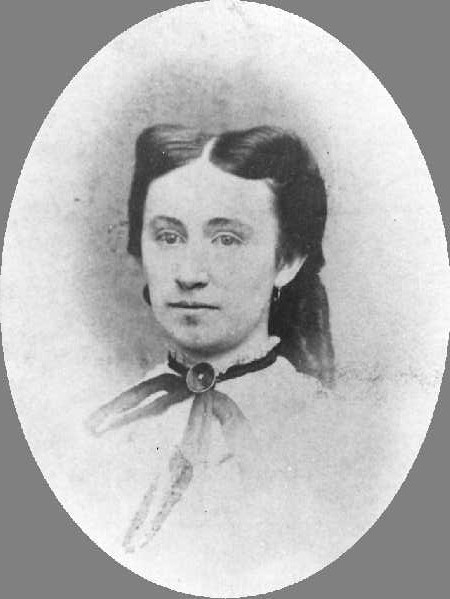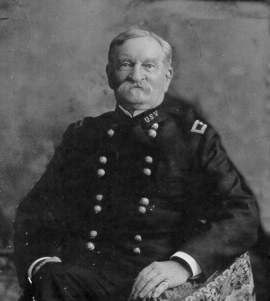Courtesy of the United States Army:
Whitside, Brigadier General Samuel M.
The greatest single contribution to Huachuca’s emergence from the category of a temporary post with the attendant primitive living conditions was the leadership and vision of Captain Samuel M. Whitside. A Civil War officer and veteran campaigner in the Army of the West, he had served at no less than twelve frontier posts in Texas, Missouri, Kansas and Arizona since 1865. The experienced Captain of Cavalry was well aware of the dangers of boredom and complacency that beset isolated outposts with makeshift facilities. By the end of 1878, he had submitted estimates for a school, library and chapel. Born of English parents in Toronto, Canada, on January 9, 1839, Whitside enlisted in New York City in the General Mounted Service, U.S. Army, and was assigned to Company K, 6th Cavalry. Before he was 21, he was promoted to Sergeant Major of the regiment.
With the expansion of the Army for the Civil War, Whitside accepted a commission to Second Lieutenant in Company K, 6th Cavalry, on November 4, 1861. During the first year of the war, he served with his regiment in the Army of the Potomac. In September 1862 he was assigned as aide-de-camp to Major General Nathaniel P. Banks who was in charge of the defense of Washington, the first of a succession of staff jobs that included serving as aide to Generals McClellan, Martindale and Pleasanton.
After the war his service was recognized by brevet ranks of Captain and Major of volunteers awarded on March 13, 1865. The permanent rank of Captain was granted on October 20, 1866, and he was given command of Troop B, 6th Cavalry, a post he would hold for the next nine years. He arrived in Arizona Territory in 1876 when his company reported to Fort Lowell. With a promotion to Major in March 1885, came reassignment from his regiment of 26 years and a new billet as a squadron commander in the 7th Cavalry stationed at Fort Meade in Dakota Territory. From there he went to Fort Riley, Kansas, until November 1890.
In the winter of 1890 he would find himself back in the thick of the action, riding at the head of his squadron in the last battle of the Indian Wars. It was Whitside’s squadron composed of four troops of the 7th Cavalry with two Hotchkiss guns that found and surrounded Big Foot’s Band. The Indians were taken to Whitside’s camp on Wounded Knee, and the major requested reinforcements. These arrived on the morning of December 29 in the form of the remainder of the 7th Cavalry regiment under Colonel G. A. Forsyth, who took command. When the soldiers attempted to disarm the Cheyennes, general fighting broke out in what would be remembered as the battle of Wounded Knee.
In July 1895, Whitside was promoted to Lieutenant Colonel, first with the 3d Cavalry and then with the 5th. In 1898, with the onset of the Spanish-American War, he was promoted to Colonel and put in command of the 10th Cavalry on October 16, 1898. He commanded the Department of Santiago and Puerto Principe, Cuba, for the first six months of 1900 and the Department of Eastern Cuba to November 15, 1900. He was appointed Brigadier General of U.S. Volunteers on January 3, 1901, and commanded the District of Santiago, Cuba, until May 21, 1902.
He received a regular army promotion to Brigadier General in 1902 and, at his own request, was placed on the retirement list on June 9, 1902, after 40 years of service. He died two years later of “acute indigestion,” on December 15, 1904, in Washington, D.C.
Born at Toronto, Canada, January 9, 1839, he joined the United States Army in 1858.
He served throughout the Civil War with the 6th United States Cavalry and then was assigned to duty on the Western frontier where he served for twenty-five years.
In December 1890 he captured Big Foot and his 400 Sioux warriors and led his regiment at the Battle of Wounded Knee.
During the Spanish-American War he commanded the 5th U.S. Cavalry and was then transferred to the 10th U.S. Cavalry in October 1898 and went to Cuba in May 1899, where he was placed in command of the Department of Santiago and Puerto Principe in January 1900. On the reorganization of the Regular Army in 1901, he was promoted to Brigadier General.
He died on December 15, 1904 and was buried in Section 2 of Arlington National Cemetery. His wife, Caroline McGavok Whitside (1845-1936), and his son, Victor M. Whitside, Major, United States Army Infantry (1886-1919), are buried with him.
Samuel is buried with his wife, Carrie, and their son Major Victor M. Whitside who died at the end of WW 1. The three of them share the same headstone that is actually a four-sided monument about 10 feet tall, (similar to the Washington Monument). Their inscriptions are written on their respective side of the monument with their plot projecting out from there. One side of the monument is blank and the plot is vacant. About a hundred yards from their plot, Warren W. Whitside and his wife, Lillian Rigney are buried together along with their son, Captain Warren W. Whitside, Jr. who served in WW II in the US Navy.
United States Army Photo

Whitside, Caroline P.
In 1878 a woman was setting up housekeeping in a little known canyon in the Huachuca Mountains.
Caroline P. McGavock (1845-1936) was born in Nashville, Tennessee, into one of the old plantation families.
At the age of 23 she married an Army officer and Civil War veteran. He was Samuel M. Whitside, who as a Captain founded and commanded Camp Huachuca in 1877.
She followed him to this remote outpost and was the first Anglo woman known to live in Huachuca Canyon. A son was born to Mrs. Whitside in April 1879 but died a little more than six months later and was buried in the new cemetery. The infant mortality rate was high on the frontier. Most of the time medical attention was unavailable and the living conditions were unhealthy. Only three of the seven children she bore survived infancy. But life was to improve for Carrie Whitside.
In the ensuing years her husband reached the rank of Brigadier General and, by the turn of the century, was the military governor of Santiago and Puerto Principe provinces during the American occupation of Cuba. Despite the hardships she endured, she lived to be 91 years, dying in 1936 at Walter Reed Hospital in Washington, D.C.
WHITSIDE, CARRIE MCGAVOCK W/O S M
DATE OF DEATH: 12/07/1936
DATE OF INTERMENT: 12/16/1938
BURIED AT: SECTION EAST SITE 853
ARLINGTON NATIONAL CEMETERY
WIFE OF SM WHITSIDE – BRIG GEN US ARMY
Michael Robert Patterson was born in Arlington and is the son of a former officer of the US Army. So it was no wonder that sooner or later his interests drew him to American history and especially to American military history. Many of his articles can be found on renowned portals like the New York Times, Washingtonpost or Wikipedia.
Reviewed by: Michael Howard

